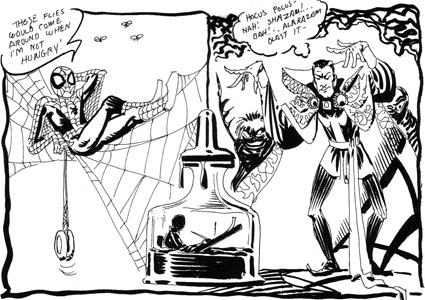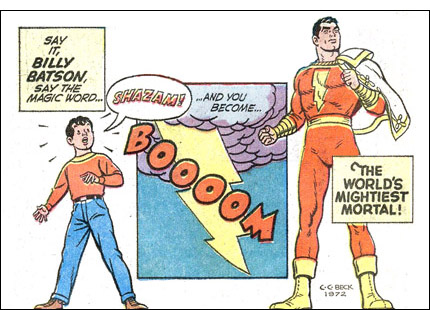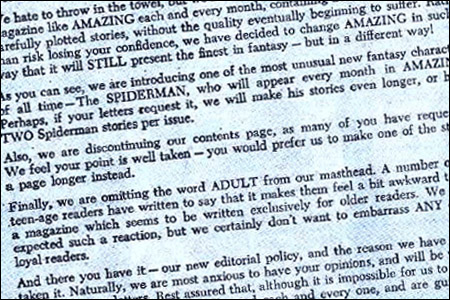
Rolling Stone has posted an article about the personal side of Steve Ditko, co-creator of Spider-Man and Doctor Strange (among others) and one of the most gifted and personally-secretive figures in the comic book industry. Since he died in 2018, the world has learned much about him through his family and will learn more.
I read the piece on the Rolling Stone site yesterday and there was much in it that I thought needed additional context or correction. Since I was so busy, I decided I'd get back to it today and write something here…but now it's behind a paywall. I don't want to pay to reread it or to write a lot about an article that you folks can't read once without paying. If you are a subscriber, you can read it here.

Three things I remember from it that I can write about: One is that it's long been part of The Official History that a rift developed between Ditko and Stan Lee that at some point led to Stan refusing to talk to Steve. That, in turn, led to Steve ultimately quitting because, as he put it in one of his much-later writings…
Why should I continue to do all these monthly issues, original story ideas, material, for a man who is too scared, too angry over something, to even see, talk to me?
Ditko had been handing his work in to production manager Sol Brodsky who, in turn, passed it on to Stan. And what he wrote may be true but…
- Both Stan and Sol told me it was the other way around; that Ditko refused to talk to Stan and would deliver the work to the office on the days when Stan was not there. It was no secret that Stan worked at home on certain days of the week.
- My pal Steve Sherman and I spent an afternoon with Ditko in 1970 — not all that long after he quit — and he didn't say anything about that. His stated reasons for leaving Marvel then were frustrations with Stan changing his stories, Stan being too often credited as the sole creator and writer of comics that Ditko largely plotted, and with the company heads not making good on promises that he would share in the merchandising and profitability of Spider-Man. And…
- I met with Stan in that office. If he was in there and didn't want to talk with me but I wanted to talk with him, I would have just walked into his office and confronted him. I don't think he kept his door locked but if he did and Ditko tried to see him, I think Ditko would have mentioned that.
As I said, Ditko's version may be true. I'm not saying it isn't; just that maybe it shouldn't be accepted at face value. Then there's this…
It's also part of the legendary tale of the creation of Spider-Man that Jack Kirby started drawing the first story and Stan stopped him after five pages and turned the job over to Ditko because Stan wanted the character to be a teenager and felt Jack was drawing the character too muscular and heroic. I don't buy that. Here's just some of what's wrong with that narrative…
- Before Jack started drawing that first story, he drew a presentation piece showing what the character would look like. Stan had okayed it.
- The story then was about a young orphan kid (roughly early teens) who lived with his aunt and uncle and who gained the powers to turn into the mighty, adult super-hero Spiderman (sans hyphen) at will thanks to a magic ring from a mysterious stranger. It was much the same way young orphan kid Billy Batson could turn when needed into the mighty, adult super-hero Captain Marvel or the way young orphan kid Tommy Troy could turn when needed into the mighty, adult super-hero The Fly. Jack wasn't supposed to be drawing a super-powered teenager. That wasn't the concept then…and a young kid turning into an only-slightly-older teenage super-hero is kind of a weird premise for a comic.

- Jack and Steve agreed that Jack drew five pages before he was stopped and that the costumed Spiderman only appeared once on those pages — in the first panel. But if that's what Stan wanted, that first panel could have been redrawn by Ditko when he inked it.
- It could also have been redrawn by Jack. Stan was never shy about asking Jack to redraw things — it was a source of frequent friction between the two men — and he apparently didn't even ask this time. He just decided not to use the five pages…which, by the way, do not seem to exist anymore. Ditko in one article said he thought he threw them away.

- And Jack could so draw teenage figures. Look at Johnny Storm in Fantastic Four. In fact, Ditko drew a cover for Amazing Fantasy #15 — the first time the comic-buying public would see the new hero — and Stan tossed it and had Jack draw a new one making Spider-Man more powerful and dynamic. He also later had Jack redraw the Spider-Man figures that Ditko drew on the covers of Amazing Spider-Man #10 and #35.
- And lastly for this list, Stan did not hand the same story to Ditko and tell him to redraw it making the character younger. They changed much of the concept of the strip. He was no longer a young kid. He was not able to turn into an adult super-hero at will. There was no magic ring or mysterious stranger. He was instead a teenager (all the time) who had super powers (all the time) and how he got those powers was completely different.
Why the changes? We may never know for sure but I have what I think is a good guess. Ditko once wrote…
Stan said Spider-Man would be a teenager with a magic ring that could transform him into an adult hero — Spider-Man. I said it sounded like The Fly, which Joe Simon had done for Archie Publications. I didn't believe Jack was involved with that feature because the issues I had seen lacked the usual Kirby flair.
I'm thinking someone was worried about a lawsuit. Simon was quite litigious and so were the folks who owned Archie. My guess is that once alerted by Ditko, Stan or someone at Marvel looked into it and decided that their new strip bore too much resemblance to The Fly. Simon was somewhat litigious and so was John Goldwater, who owned the Archie company. Ergo, the theory sez, they decided the strip required major changing. Logical deduction, right? Right — but it has this hole in it: I asked both Stan and Jack and neither man recalled that as a concern.
Which doesn't mean it wasn't the reason. Anyway, I think that Stan didn't decide to make the new spidery hero a full-time teen until after Kirby's pages were discarded and they needed to differentiate the strip from what Simon and Kirby had done. Something is wrong with the "Jack made him too muscular" explanation. (Note how in Ditko's above-quoted recollection, he recalls Stan saying the strip Jack was then drawing was about "a teenager with a magic ring that could transform him into an adult hero.")
And the third thing that the Rolling Stone article said that brings up another theory is the story that Stan and Steve did that first Spider-Man story in Amazing Fantasy #15 knowing it was the final issue so they got experimental with it. My theory — and it's not just mine; others came up with this — is that they didn't find out it was the final issue until well after it had gone to press.
Which is why #15 tells you twice — once at the end of the Spider-Man story and again on the letters page — to make sure to not miss future issues. It does not say — and this was the kind of hype Stan excelled in — "This is the last issue unless you readers get together and buy lots of copies and tell your friends and floor our publisher with letters demanding more Spider-Man!"

What some of us believe is that after finishing that 11-page Spider-Man origin story that ran in Amazing Fantasy #15, Stan and Steve created a 14-page Spider-Man story about an astronaut that was planned for Amazing Fantasy #16. Then they at least started on a 14-page Spider-Man story for Amazing Fantasy #17 about a villain called The Vulture. In each issue, the lead Spider-Man story would have been followed by a couple of the short non-series fantasy stories that had appeared previously in that comic like the two non-series fantasy stories that ran in #15 after the first Spider-Man story.
But before #16 went to press, the company's publisher Martin Goodman decided to pull the plug on Amazing Fantasy. This would have been before he had any sales figures on #15 and it would not have been unusual for Goodman to do such a thing. He did tend to cancel a book, then see later sales reports and decide to bring it back…especially when he had purchased-but-unpublished material on the shelf.
Soon after, he got some encouraging response (sales figures and letters) for #15 and since he had that already-paid-for Spider-Man material on the shelf, he okayed a new comic called Amazing Spider-Man. #1 featured the astronaut story plus a newly-concocted ten-page Spider-Man story to fill out the issue. And #2 featured the Vulture story followed by another newly-created ten-page Spider-Man story. That would explain why Amazing Spider-Man didn't feature one book-length story — like all the other Marvel super-hero titles did in their first issues and almost every one thereafter — until #3.
There were a few other things in the Rolling Stone piece that I might have something to say about. It's overall a good article and its author reveals some things I'd never heard before. If it comes out from behind the paywall, make sure you read it. It might even be worth buying a subscription. I just think there are some illogical things about the way the story of how Spider-Man was created is usually told.